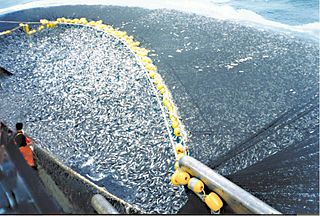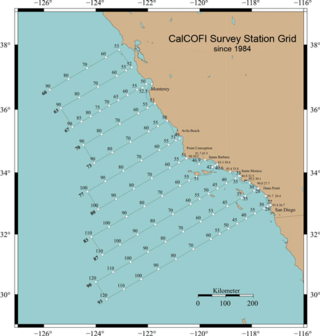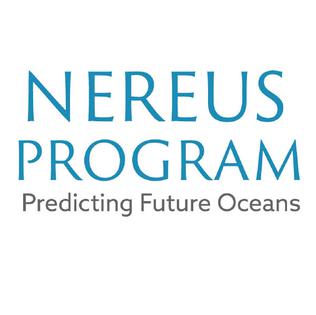
FishBase is a global species database of fish species. It is the largest and most extensively accessed online database on adult finfish on the web. Over time it has "evolved into a dynamic and versatile ecological tool" that is widely cited in scholarly publications.

Overfishing is the removal of a species of fish from a body of water at a rate greater than that the species can replenish its population naturally, resulting in the species becoming increasingly underpopulated in that area. Overfishing can occur in water bodies of any sizes, such as ponds, wetlands, rivers, lakes or oceans, and can result in resource depletion, reduced biological growth rates and low biomass levels. Sustained overfishing can lead to critical depensation, where the fish population is no longer able to sustain itself. Some forms of overfishing, such as the overfishing of sharks, has led to the upset of entire marine ecosystems. Types of overfishing include growth overfishing, recruitment overfishing, and ecosystem overfishing. Overfishing not only causes negative impacts on biodiversity and ecosystem functioning, but also reduces fish production, which subsequently leads to negative social and economic consequences.

A conventional idea of a sustainable fishery is that it is one that is harvested at a sustainable rate, where the fish population does not decline over time because of fishing practices. Sustainability in fisheries combines theoretical disciplines, such as the population dynamics of fisheries, with practical strategies, such as avoiding overfishing through techniques such as individual fishing quotas, curtailing destructive and illegal fishing practices by lobbying for appropriate law and policy, setting up protected areas, restoring collapsed fisheries, incorporating all externalities involved in harvesting marine ecosystems into fishery economics, educating stakeholders and the wider public, and developing independent certification programs.

The goal of fisheries management is to produce sustainable biological, environmental and socioeconomic benefits from renewable aquatic resources. Wild fisheries are classified as renewable when the organisms of interest produce an annual biological surplus that with judicious management can be harvested without reducing future productivity. Fishery management employs activities that protect fishery resources so sustainable exploitation is possible, drawing on fisheries science and possibly including the precautionary principle.
Regime shifts are large, abrupt, persistent changes in the structure and function of ecosystems, the climate, financial systems or other complex systems. A regime is a characteristic behaviour of a system which is maintained by mutually reinforced processes or feedbacks. Regimes are considered persistent relative to the time period over which the shift occurs. The change of regimes, or the shift, usually occurs when a smooth change in an internal process (feedback) or a single disturbance triggers a completely different system behavior. Although such non-linear changes have been widely studied in different disciplines ranging from atoms to climate dynamics, regime shifts have gained importance in ecology because they can substantially affect the flow of ecosystem services that societies rely upon, such as provision of food, clean water or climate regulation. Moreover, regime shift occurrence is expected to increase as human influence on the planet increases – the Anthropocene – including current trends on human induced climate change and biodiversity loss. When regime shifts are associated with a critical or bifurcation point, they may also be referred to as critical transitions.
The Sea Around Us is an international research initiative and a member of the Global Fisheries Cluster at the University of British Columbia. The Sea Around Us assesses the impact of fisheries on the marine ecosystems of the world and offers mitigating solutions to a range of stakeholders. To achieve this, the Sea Around Us presents fisheries and fisheries-related data at spatial scales that have ecological and policy relevance, such as by Exclusive Economic Zones, High Seas areas, Large Marine Ecosystems and Ecosystems.

An ecosystem model is an abstract, usually mathematical, representation of an ecological system, which is studied to better understand the real system.

CalCOFI is a multi-agency partnership formed in 1949 to investigate the collapse of the sardine population off California. The organization's members are from NOAA Fisheries Service, Scripps Institution of Oceanography, and California Department of Fish and Wildlife. The scope of this research has evolved into the study of marine ecosystems off California and the management of its fisheries resources. In 2004, the CalCOFI survey area became one of 26 Long Term Ecological Research Network (LTER) research sites. This time-series of oceanographic and fisheries data allows scientists to assess the human impact and effects of climate change on the coastal ocean ecosystem. CalCOFI hydrographic and biological data, publications, and web information are distributed for use without restriction under the terms of the GNU Free Documentation License.

The trophic level of an organism is the position it occupies in a food web. Within a food web, a food chain is a succession of organisms that eat other organisms and may, in turn, be eaten themselves. The trophic level of an organism is the number of steps it is from the start of the chain. A food web starts at trophic level 1 with primary producers such as plants, can move to herbivores at level 2, carnivores at level 3 or higher, and typically finish with apex predators at level 4 or 5. The path along the chain can form either a one-way flow or a part of a wider food "web". Ecological communities with higher biodiversity form more complex trophic paths.
Ecosystem-based management is an environmental management approach that recognizes the full array of interactions within an ecosystem, including humans, rather than considering single issues, species, or ecosystem services in isolation. It can be applied to studies in the terrestrial and aquatic environments with challenges being attributed to both. In the marine realm, they are highly challenging to quantify due to highly migratory species as well as rapidly changing environmental and anthropogenic factors that can alter the habitat rather quickly. To be able to manage fisheries efficiently and effectively it has become increasingly more pertinent to understand not only the biological aspects of the species being studied, but also the environmental variables they are experiencing. Population abundance and structure, life history traits, competition with other species, where the stock is in the local food web, tidal fluctuations, salinity patterns and anthropogenic influences are among the variables that must be taken into account to fully understand the implementation of a "ecosystem-based management" approach. Interest in ecosystem-based management in the marine realm has developed more recently, in response to increasing recognition of the declining state of fisheries and ocean ecosystems. However, due to a lack of a clear definition and the diversity involved with the environment, the implementation has been lagging. In freshwater lake ecosystems, it has been shown that ecosystem-based habitat management is more effective for enhancing fish populations than management alternatives.
Carl Walters is an American-born Canadian biologist known for his work involving fisheries stock assessments, the adaptive management concept, and ecosystem modeling. Walters has been a professor of Zoology and Fisheries at the University of British Columbia since 1969. He is one of the main developers of the ecological modelling software Ecopath. His most recent work focuses on how to adjust human behaviors in environments that are full of uncertainty. He is a recent recipient of the Volvo Environment Prize (2006). In 2019, Dr. Walters became a Member of the Order of British Columbia.

Ray Hilborn is a marine biologist and fisheries scientist, known for his work on conservation and natural resource management in the context of fisheries. He is currently professor of aquatic and fishery science at the University of Washington. He focuses on conservation, natural resource management, fisheries stock assessment and risk analysis, and advises several international fisheries commissions and agencies.
Villy Christensen is an ecosystem modeller with a background in fisheries science. He is known for his work as a project leader and core developer of Ecopath, an ecosystem modelling software system widely used in fisheries management. Ecopath was initially an initiative of the NOAA, but since primarily developed at the UBC Fisheries Centre of the University of British Columbia. In 2007, it was named as one of the ten biggest scientific breakthroughs in NOAA's 200-year history. The citation states that Ecopath "revolutionized scientists' ability worldwide to understand complex marine ecosystems".

Fishing down the food web is the process whereby fisheries in a given ecosystem, "having depleted the large predatory fish on top of the food web, turn to increasingly smaller species, finally ending up with previously spurned small fish and invertebrates".
SeaLifeBase is a global online database of information about marine life. It aims to provide key information on the taxonomy, distribution and ecology of all marine species in the world apart from finfish. SeaLifeBase is in partnership with the WorldFish Center in Malaysia and the UBC Institute for the Oceans and Fisheries at the University of British Columbia. Daniel Pauly is the principal investigator and it is coordinated by Maria Lourdes D. Palomares. As of March 2023, it included descriptions of 85,000 species, 59,400 common names, 15,500 pictures, and references to 39,300 works in the scientific literature. SeaLifeBase complements FishBase, which provides parallel information for finfish.
PCLake is a dynamic, mathematical model used to study eutrophication effects in shallow lakes and ponds. PCLake models explicitly the most important biotic groups and their interrelations, within the general framework of nutrient cycles. PCLake is used both by scientist and water managers. PCLake is in 2019 extended to PCLake+, which can be applied to stratifying lakes.
The following outline is provided as an overview of and topical guide to fisheries:

The Nereus Program is a global interdisciplinary initiative between the Nippon Foundation and the University of British Columbia that was created to further our knowledge of how best to attain sustainability for our world’s oceans. In addition to the Nippon Foundation and UBC, the program partners with University of Cambridge, Duke University, Princeton University, Stockholm University, United Nations Environment Program-World Conservation Monitoring Centre and Utrecht University. The program is built around three core objectives: to conduct collaborative ocean research across the natural and social sciences, to develop an interdisciplinary network of experts that can engage in discussion of complex and multifaceted questions of ocean sustainability, and to transfer these ideas to practical solutions in global policy forums.
Jeffrey Polovina is an American marine scientist. He is known for creating the marine ecosystem model Ecopath.
The Fisheries and Marine Ecosystem Model Intercomparison Project (Fish-MIP) is a marine biology project to compare computer models of the impact of climate change on sea life. Founded in 2013 as part of the Inter-Sectoral Impact Model Intercomparison Project (ISIMIP), it was established to answer questions about the future of marine biodiversity, seafood supply, fisheries, and marine ecosystem functioning in the context of various climate change scenarios. It combines diverse marine ecosystem models from both the global and regional scale through a standardized protocol for ensemble modelling in an attempt to correct for any bias in the individual models that make up the ensemble. Fish-MIP's goal is to use this ensemble modelling to project a more robust picture of the future state of fisheries and marine ecosystems under the impacts of climate change, and ultimately to help inform fishing policy.












